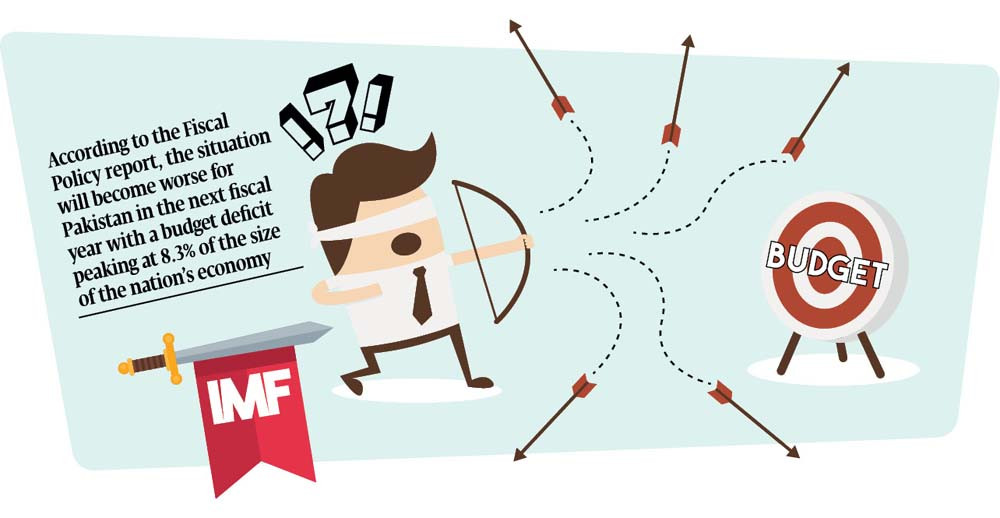Pakistan in breach of all fiscal targets
Deficit may widen to as high as 6.8% by June this year

An International Monetary Fund (IMF) report has revealed that Pakistan will miss the fiscal and debt reduction targets of this fiscal year and the situation will become worse in the next fiscal year with a budget deficit peaking at 8.3% of the size of the nation’s economy.
The Fiscal Monitor report, released on the side-lines of the IMF Spring Meetings, showed that Pakistan will miss all targets related to the reduction of the budget deficit, gross public debt, and expenditures and increasing revenues during FY2022-23 and FY2023-24.
Compared to an eight-month-old assessment of booking a budget deficit of 4.7% of the GDP, the Fiscal Monitor report showed that the deficit may widen to as high as 6.8% by June this year. There is a slippage of 2.1% of the GDP or Rs1.8 trillion, underscoring the poor performance of the incumbent government.
This also puts a question mark on the performance of the $6.5 billion Extended Fund Facility whose objectives were fiscal consolidation and putting the country on a sustainable path towards debt reduction.
The IMF report further showed that during FY2023-24, starting from July, the budget deficit can go to as high as 8.3% of the GDP. In August last year, the IMF had projected the budget deficit for the next fiscal year at 4% of the GDP. Within eight months, the IMF has shown massive deterioration in the core budget target.
Under the $6.5 billion bailout package, the IMF had targeted Pakistan achieving a primary budget surplus – a measure that shows that government revenues are higher than its expenditures excluding interest payments. The primary budget surplus had been boasted as a strategy to reduce public debt.

design: mohsin alam
According to the Fiscal Monitor report, however, during the current fiscal year instead of achieving any surplus, Pakistan will have a primary budget deficit equal to at least 0.5% of the GDP. Compared to just eight months ago, there is a deviation of around 0.7% or Rs600 billion at the current projected size of the economy.
During the eight review talks in August last year, the IMF spent a significant time ensuring Pakistan achieves a nominal primary surplus of 0.2% of the GDP. This has not materialised. For FY2023-24, the IMF has projected a primary deficit of 0.4% of the size of the economy compared to its old assessment of having about 0.6% surplus.
Pakistan’s indicators are deteriorating at a time when these core numbers are showing improvement in other countries. The Fiscal Monitor report stated that three years after the outbreak of the Covid-19 pandemic, fiscal policy was returning to normal. After providing extraordinary support simultaneously in 2020, both monetary and fiscal policy tightened in nearly three-quarters of countries in 2022 amid high inflation and the expiration of pandemic-related spending measures. This shift occurred in a highly volatile environment.
The report further stated that following a historic surge in global public debt to nearly 100% of GDP in 2020, as a result of economic contraction and massive government support, fiscal deficits have since declined, as exceptional measures have come to an end. With strong nominal GDP growth in 2021–22, global debt posted the steepest decline in 70 years and stood at about 92% of GDP at the end of 2022, still about eight percentage points above the level at the end of 2019
Primary deficits were also falling rapidly and moving closer to pre-pandemic levels in many countries, but overall deficits have fallen somewhat less owing to rising interest payments. The report showed that Pakistan’s revenue-to-GDP ratio may also remain below the levels assessed earlier. It is now projected at 12.2% of the GDP, which should also be a matter of concern for the IMF that will also miss its programme targets. For the next fiscal year, the IMF has projected revenues at just 12.5% of the GDP.
The Federal Board of Revenue has been struggling to achieve its annual target and has already booked a Rs276 billion shortfall in just nine months of the fiscal year.
Compared to this, expenditures will remain far higher than the old assessments. For the current fiscal year, the IMF has projected expenditures to grow to 19.1% of the GDP, breaching the earlier projection by as much as 2% or Rs1.7 trillion. The situation will not improve in the next fiscal year either, as the report shows the expenses increasing to 20.8% of the GDP – exceeding the earlier estimates by a margin of at least Rs3.4 trillion at the current projected size of the economy.
As a result of these poor indicators, gross public debt is shown at 73.6% of the GDP by end of this fiscal year. At the time of signing of the programme in July 2019, the IMF had projected that Pakistan’s public debt would come down to 65% of the GDP. For the next fiscal year, the IMF has shown a significant reduction in debt by projecting it at 69% of the GDP – an assessment that may again be proved wrong.
The Fiscal Monitor report stated that debt dynamics deteriorated in emerging market economies and low-income developing countries with sizable shares of debt in foreign currency, as currency depreciation and rising interest rates came together with inflation.
In the past year, the Pakistan rupee has devalued by more than 56% – a record fall – while inflation in Pakistan peaked at a 50-year at 35.4% in March.
Published in The Express Tribune, April 13th, 2023.
Like Business on Facebook, follow @TribuneBiz on Twitter to stay informed and join in the conversation.



















COMMENTS
Comments are moderated and generally will be posted if they are on-topic and not abusive.
For more information, please see our Comments FAQ